Gerry Adams's Blog, page 31
June 14, 2019
Telling it as it was - ‘Ireland’s War of Independence 1919-21: The IRAs Guerrilla Campaign’
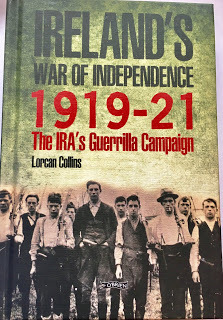
The revision of history, as new facts emerge and details or stories previously unknown are revealed, is a good and a necessary part of learning about the past. But ‘revisionism,’ which seeks to perpetuate a particular version of history by distorting, suppressing or ignoring elements of the story, usually only serves the establishment’s interests. So, it has been in Ireland for a very long time.The history of struggle in Ireland, and in particular of the revolutionary period, has been dumbed down and distorted. This has included a significant effort to differentiate between the IRA of 1916-1923 and its actions, and the IRA after that. It also includes the notion that we have won our freedom and that the southern state is the nation and so on.The availability of much new historical and military documents and manuscripts from the revolutionary period has broken down much of this. The digitalisation and wider availability of this new material, and the emergence of a younger cadre of historians, has opened up history and undermined the myths perpetuated by the ‘revisionist’ school. One of these historians is Lorcan Collins.
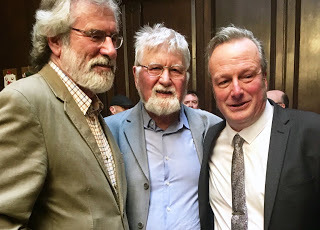 Mise agus Michael O'Brien and Lorcan CollinsA couple of weeks ago I was asked by Michael O’Brien of O’Brien Press to speak at the launch of Lorcan’s latest book - ‘Ireland’s War of Independence 1919-21: The IRAs Guerrilla Campaign’. Along with the late Shane Kenna, and the late Shane Mac Thomáis, and his father Eamonn, and the very alive Liz Gillis, Donal Fallon, Conor McNamara, Micheál MacDonnacha, Margaret Ward, Breandán Mac Suibhne, Mary McAuliffe, John O’Neill and Aengus O Snodaigh and many others, they are the alternative to the dumbing down of our history.For over 20 years Lorcan has been running his Dublin Walking Tours, talking to visitors about the momentous events of Easter 1916, bringing them to the sites of battle, and telling them stories of the courageous men and women who took on the might of the British Empire. His knowledge of that period is amazing. Lorcan has also published a number of books, including The Easter Rising: A guide to Dublin in 1916; and 1916: The Rising Handbook. It was Lorcan who suggested to O’Brien Press that, as part of the centenary celebrations for 1916, that they publish the 16 Lives series which recounts the lives of each of the leaders executed by British after the Easter Rising. Lorcan wrote the book on James Connolly.His latest work, ‘Ireland’s War of Independence 1919-21: The IRAs Guerrilla Campaign’ is a timely publication. It’s a nice book. It’s a handy size of a book. When you get a new book there is a feel to it, a smell to it. Lorcan’s book presents short, well researched, and insightful accounts about the major events and personalities of that period. Unlike most history books which require you start at the first page and work your way through to the end, this book is written in a style that allows the reader to dip in and out of it. To go back to it and pick it up if you have a specific interest in an aspect of the period.
Mise agus Michael O'Brien and Lorcan CollinsA couple of weeks ago I was asked by Michael O’Brien of O’Brien Press to speak at the launch of Lorcan’s latest book - ‘Ireland’s War of Independence 1919-21: The IRAs Guerrilla Campaign’. Along with the late Shane Kenna, and the late Shane Mac Thomáis, and his father Eamonn, and the very alive Liz Gillis, Donal Fallon, Conor McNamara, Micheál MacDonnacha, Margaret Ward, Breandán Mac Suibhne, Mary McAuliffe, John O’Neill and Aengus O Snodaigh and many others, they are the alternative to the dumbing down of our history.For over 20 years Lorcan has been running his Dublin Walking Tours, talking to visitors about the momentous events of Easter 1916, bringing them to the sites of battle, and telling them stories of the courageous men and women who took on the might of the British Empire. His knowledge of that period is amazing. Lorcan has also published a number of books, including The Easter Rising: A guide to Dublin in 1916; and 1916: The Rising Handbook. It was Lorcan who suggested to O’Brien Press that, as part of the centenary celebrations for 1916, that they publish the 16 Lives series which recounts the lives of each of the leaders executed by British after the Easter Rising. Lorcan wrote the book on James Connolly.His latest work, ‘Ireland’s War of Independence 1919-21: The IRAs Guerrilla Campaign’ is a timely publication. It’s a nice book. It’s a handy size of a book. When you get a new book there is a feel to it, a smell to it. Lorcan’s book presents short, well researched, and insightful accounts about the major events and personalities of that period. Unlike most history books which require you start at the first page and work your way through to the end, this book is written in a style that allows the reader to dip in and out of it. To go back to it and pick it up if you have a specific interest in an aspect of the period.
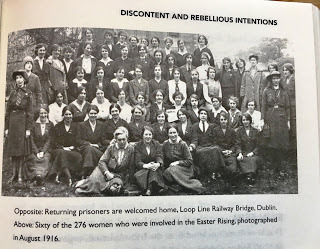 Where other historians have often diminished or simply ignored the role of women in the struggle for Independence Lorcan writes about the “Radical Women” – Inghinidhe na hÉireann, Bean na hÉireann, Cumann na mBan, and also those sisters who fought with the Irish Citizen Army.One of the great strengths of this book is Lorcan’s ability to merge history with storytelling. The characters involved in operations against the British forces become more than just names in a history book. They are real people living and dying in a very dangerous time in our history.Lorcan recalls the story of British Army Captain Percival Lea-Wilson. He subjected the GPO Garrison, after they surrendered to savage abuse. Wilson is said to have been especially vicious toward Tom Clarke and Seán MacDiarmada. Lorcan tells how Liam Tobin who had witnessed Wilson’s savagery “registered a vow” to “deal with him at some time in the future.”Four years later Wilson was a District Inspector for Gorey in Wexford. Liam Tobin was now Michael Collins’s Chief of Intelligence and in June 1920 he travelled to Wexford where he ambushed and killed Wilson. War can be a deeply personal business.
Where other historians have often diminished or simply ignored the role of women in the struggle for Independence Lorcan writes about the “Radical Women” – Inghinidhe na hÉireann, Bean na hÉireann, Cumann na mBan, and also those sisters who fought with the Irish Citizen Army.One of the great strengths of this book is Lorcan’s ability to merge history with storytelling. The characters involved in operations against the British forces become more than just names in a history book. They are real people living and dying in a very dangerous time in our history.Lorcan recalls the story of British Army Captain Percival Lea-Wilson. He subjected the GPO Garrison, after they surrendered to savage abuse. Wilson is said to have been especially vicious toward Tom Clarke and Seán MacDiarmada. Lorcan tells how Liam Tobin who had witnessed Wilson’s savagery “registered a vow” to “deal with him at some time in the future.”Four years later Wilson was a District Inspector for Gorey in Wexford. Liam Tobin was now Michael Collins’s Chief of Intelligence and in June 1920 he travelled to Wexford where he ambushed and killed Wilson. War can be a deeply personal business.
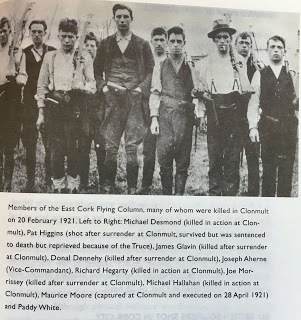 There are many stories of daring raids on RIC barracks; executions by the ‘Squad’ of British agents and spies; including the targeting of the Cairo Gang, and then the British retaliation later that day in Croke Park.Reading the book I came across an aspect to these two incidents I wasn’t aware of before. In a little section under ‘House of Commons Reaction’ Lorcan tells us how the Secretary of State for Ireland Hamar Greenwood read through the list of the dead British agents to a packed British Commons.Lorcan describes Greenwood; “pausing slowly for effect and whipping the House into a frenzy with the use of phrases such as ‘possible a hammer was used as well as shots to finish off this gallant officer.’ After much discussion and calls for further powers to be extended to the military and police, Joe Devlin, the Irish Party MP for the Falls Road area of Belfast, rose to ask Lloyd George and Greenwood why there had been no mention of the killings in Croke Park. There were shouts of ‘sit down’ from hundreds of MPs, and Greenwood whispered something to his fellow MP, Major John Molson, who lunged at Devlin, grabbing him by the neck and pulling him over the bench, egged on by shouts of ‘kill him, kill him’ from MPs.”So, the madness of Brexit didn’t just appear out of thin air.
There are many stories of daring raids on RIC barracks; executions by the ‘Squad’ of British agents and spies; including the targeting of the Cairo Gang, and then the British retaliation later that day in Croke Park.Reading the book I came across an aspect to these two incidents I wasn’t aware of before. In a little section under ‘House of Commons Reaction’ Lorcan tells us how the Secretary of State for Ireland Hamar Greenwood read through the list of the dead British agents to a packed British Commons.Lorcan describes Greenwood; “pausing slowly for effect and whipping the House into a frenzy with the use of phrases such as ‘possible a hammer was used as well as shots to finish off this gallant officer.’ After much discussion and calls for further powers to be extended to the military and police, Joe Devlin, the Irish Party MP for the Falls Road area of Belfast, rose to ask Lloyd George and Greenwood why there had been no mention of the killings in Croke Park. There were shouts of ‘sit down’ from hundreds of MPs, and Greenwood whispered something to his fellow MP, Major John Molson, who lunged at Devlin, grabbing him by the neck and pulling him over the bench, egged on by shouts of ‘kill him, kill him’ from MPs.”So, the madness of Brexit didn’t just appear out of thin air.
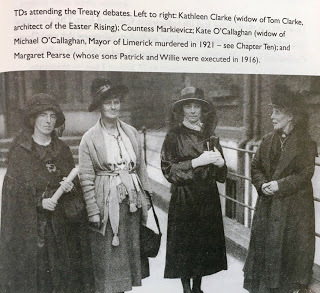 Another of the many stories Lorcan relates is that of Kevin Barry. Most of us know that Barry – a lad of eighteen summers – was hanged by the British. What is less well known are the two attempts by the IRA to rescue Barry. One of these involved a plan to blow a hole in the wall of Mountjoy Prison and rush the armed British guards. It was called off because too many people arrived outside the prison to pray for Kevin Barry as he awaited his fate.The song of his death has been sung many times by many people including Leonard Cohen, Paul Robeson, the Clancy Brothers and most recently by Boy George. Pól Mac Adaim sang it as Lorcan’s book launch. Most of us will have sang it at some point in our own lives. It captures the heroism and tragedy of the struggle for Irish freedom.So does ‘Ireland’s War of Independence 1919-21: The IRAs Guerrilla Campaign’. It tells it as it was.
Another of the many stories Lorcan relates is that of Kevin Barry. Most of us know that Barry – a lad of eighteen summers – was hanged by the British. What is less well known are the two attempts by the IRA to rescue Barry. One of these involved a plan to blow a hole in the wall of Mountjoy Prison and rush the armed British guards. It was called off because too many people arrived outside the prison to pray for Kevin Barry as he awaited his fate.The song of his death has been sung many times by many people including Leonard Cohen, Paul Robeson, the Clancy Brothers and most recently by Boy George. Pól Mac Adaim sang it as Lorcan’s book launch. Most of us will have sang it at some point in our own lives. It captures the heroism and tragedy of the struggle for Irish freedom.So does ‘Ireland’s War of Independence 1919-21: The IRAs Guerrilla Campaign’. It tells it as it was.
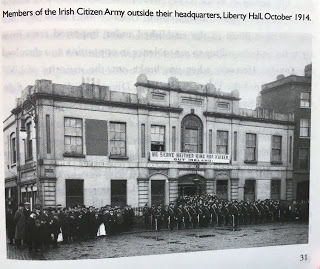
Published on June 14, 2019 04:23
June 6, 2019
Planning for Irish Unity.
The debate about the future, about a new Ireland and the demand for a referendum on Unity is growing. Civic nationalism in the North has found its voice and is energised on the demand for rights and for a Unity referendum. It is not alone in talking about this issue and discussing its implications.
Increasingly there are also voices being raised from within unionism on the issue of unity. In part this is because of the shambles that is Brexit and the social, political and economic implications this will have for all of society in the North and across our little island.
But demographic and political changes in northern society are also playing an important role in encouraging this debate. The 2011 census in the north was a watershed moment in the North’s political journey. Up to that point the issue of unity was for many – especially within unionism – an academic exercise on an outcome that many never thought would happen. The threat of unity was often used by unionist politicians to frighten unionist voters. But no one within the political leadership of unionism ever publicly acknowledged that fundamental change in the constitutional status of the North was ever a possibility. Why would they?
The northern state was a gerrymandered entity, created on the basis of a sectarian headcount. It provided unionism with what was believed in 1920 to be a permanent, in-built two thirds majority. Unionism then set about consolidating its dominance further through discrimination in housing and employment and in the gerrymandering of electoral boundaries.
Almost a century later the 2011 census – which for the first time asked citizens about their political identity – revealed that less than half (48%) identified as British. A report published in May – Sectarianism in Northern Ireland: A Review by Prof. Duncan Morrow examined the North’s changing demographics. It said: “There is a clear statistical trend towards a change in the religious minority-majority structure of Northern Ireland. On a strict analysis of identity, there is no longer a Protestant majority in Northern Ireland. There is a measurable trend towards a Catholic majority within Northern Ireland.”
While it acknowledged that it is uncertain the “extent to which this translates into choices about national identity” nonetheless the report reinforces the reality that significant demographic change is occurring.
This is underlined in the election results of recent years. In the 2017 Assembly election unionist parties lost their majority for the first time since partition. In the European election two weeks ago the combined nationalist vote was greater than that of the unionist parties and only one unionist MEP was elected. In the local government elections a few weeks earlier the total number of Unionist Councillors elected (206), from all of the Unionist parties, was less than 50% of the total number of Councillors for the North.At the same time a Red C exit poll on May 24th in the local government and European elections in the South indicated that 65% of voters would vote in favour of a United Ireland if a referendum was held the following day. If you excluded undecided and non-voters 77% were in favour of Irish unity. This has been a consistent trend in almost every opinion poll going back decades in that part of the island.
That same weekend Eileen Paisley, the widow of former DUP Leader and First Minister Ian Paisley, said of partition; “perhaps that was a wrong division.” Mrs Paisley was speaking on a BBC radio programme.
When asked if she could live in a United Ireland Eileen Paisley said: “It would depend, I suppose on what, on how it was being ruled… I would like to think I could. It would take a lot to move me out of it … there are people of sense and sensibility who do not want to be fighting with their neighbours or their friends and who want to have it properly united.”
Writing in the Irish Times last Friday Alex Kane, a former director of communications for the Ulster Unionist party acknowledged that there will be a “border poll” and that “unionism needs to be ready for that eventuality.” He also disagreed with Seamus Mallon’s recent proposal that the Good Friday Agreement should be re-written to provide unionism with a further veto over progress. Kane said: “I disagree with him that 50.1 per cent wouldn’t be enough to constitute victory for unity: it would certainly be enough for me if it was the margin of victory for the pro-UK side.”
Last July, former First Minister Peter Robinson told the MacGill Summer School that while he did not think the North would want to leave the union with Britain he believed that it was important to prepare for the possibility of a united Ireland. Robinson said that he would accept the results of a poll. “As soon as that decision is taken every democrat will have to accept that decision.” He also said that unionists would want “protections.”
This need for ‘protections’ has long been recognised by republicans and nationalists. No one I know who wants a United Ireland believes that it should be any other than a warm house for unionism, built on a foundation of equality and inclusiveness. This is evident in the debate taking place on the unity issue.
At the start of the year the group called ‘Ireland’s Future’ held a very positive conference in Belfast’s Waterfront Hall to discuss the Brexit debacle (Beyond Brexit – The Future of Ireland). Last month it held an equally successful conference in Newry entitled "Our Rights Our Future". A central plank of its debates has focused on how unionism can be encouraged to engage on unity and what rights protections are needed to obviate any fears.
Sinn Féin may be the most vocal United Ireland party but we are not the only one. Fianna Fáil, Fine Gael and the Irish Labour Party have dusted down their uniting Ireland positions. Some republicans may dismiss that as rhetoric from these parties. That misses the point. Of course it’s rhetoric. But it is also popular, so the Taoiseach and the Fianna Fáil leader will continue with it. Our task is to get them to move beyond the rhetoric. To follow the logic of their utterances. To move from platitudes to planning. Others too must be encouraged to engage in this necessary work if the questions that everyone is asking are to be answered.
So rhetoric is not enough. The Irish Government has a duty to plan for unity. There is a constitutional imperative on Dublin ‘to unite all the people who share the territory of the island of Ireland’. This cannot be accomplished without a plan. Uachtarán Shinn Féin, Mary Lou McDonald TD has called on the Irish Government to establish a Forum for Unity, to build for unity and plan for unity.
The Irish government needs to open up consultations on how this might be done.
· It needs to consult - to ask what kind of united Ireland do we all want?· There needs to be a process of dialogue.· What shape should that dialogue take?· There needs to be a transition phase after a referendum which votes for unity.· What form and how long should that transition take?
This needs planned now. Not after the referendum. That is the one big lesson of Brexit. A referendum without a plan is stupid. So a referendum on unity must be set in a thoughtful inclusive process which sets out a programme of sustainable options. Including phases of transition.
What accommodations are needed to persuade political unionism that a United Ireland can work for it? Key to this is the need for it to be an agreed shared Ireland. What happens to the political institutions established by the Good Friday Agreement?
Winning support for a United Ireland is not just about persuading unionists although that is crucial. Everyone needs to be convinced of the advantages of unity – personal, economic, wages, health provision, environmental, cultural, peace, prosperity. .There will be a referendum on Irish Unity. I am confident of this. Winning that referendum is the biggest single challenge facing United Irelanders.
Published on June 06, 2019 00:51
May 31, 2019
Honouring Pat, Marguerite and Green Cross.
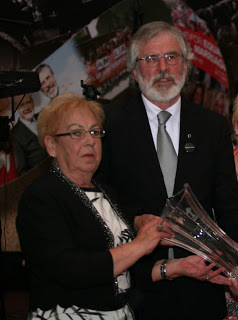 Mise agus Pat McGivern
Mise agus Pat McGivernI had the pleasure at the recent Belfast Sinn Féin Cairde event to make presentations to Marguerite Gallagher and Pat McGivern – two strong, indomitable and committed republican activists. Two tireless, hard-working stalwarts of Green Cross who have been working on behalf of republican prisoners and their families for decades. Unfortunately, Marguerite was unable to be present on the night. She was ill. But I visited her several days later. Pat McGivern was there. Both women, like many other women of their generation, have been working away diligently and sometimes invisibly for over half a century and longer to advance the objective of Irish unity and in support of prisoners and their families. If our movement was a building these women, and other women like them, are the foundation, corner stones and the scaffolding which holds our structures together in good times and in bad.
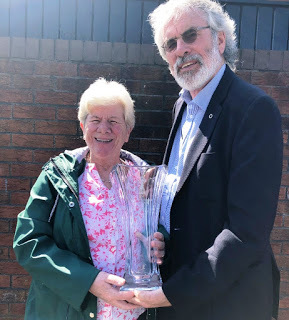 Mise agus Marguerite
Mise agus MargueriteAs well as collecting Green Cross, fighting election campaigns, and working within their local communities Pat and Marguerite have staffed the Green Cross book shop - Siopa an Ealaine – at the Sinn Féin centre on the Falls Road for over 30 years. They have been for the many thousands of tourists and visitors the smiling, welcoming face of Irish Republicanism.Both women have demonstrated enormous courage through their work in the shop. Despite the threats and harassment from British soldiers and unionist death squads it was always opened. They were there in February 1992 when RUC officer Allan Moore, pretending to be a journalist, went into the Sinn Féin advice centre next door to the shop and opened fire killing Paddy Loughran, Pat McBride, and Michael O'Dwyer. When Moore left the building he was grabbed by the arm by Marguerite who was dragged by him to his car which was parked in Sevastopol Street. He pushed her away and drove off.Both Pat and Marguerite come from the Falls. Marguerite comes from a spinal republican family – the O’Neill’s – but Pat is equally steeped in local republican activism. All of the events of the last half a century that visited that part of our city of Belfast – the pogroms, the Falls curfew, internment, the hunger strikes, numerous incidents, atrocities and attacks, the elections, all of the elections – Marguerite and Pat, like many other women, were there.
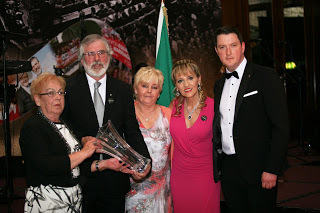 Pat and Marguerite were particularly centrally involved in the Green Cross. That organisation, which was founded in 1973, provided much needed support for prisoners and their families. They follow a long and honourable tradition of like-minded activists who in the midst of conflict have come together to support prisoners and their families. A century ago, in the aftermath of 1916 Cumann na mBan founded the White Cross. Sorcha McMahon, Áine Ceannt and Kathleen Clarke established the Irish Volunteer Dependent’s Fund. When John Reynolds a Volunteer who had escaped from the GPO signed the first cheques on behalf of the Volunteer Dependent’s Fund he was ordered to leave the country by the British. From that point on fund raising in support of prisoners largely fell to the women activists. In every subsequent phase of struggle there have been similar organisations. An Cumann Cabhrach was founded in November 1953. The objects of the Committee were stated to be:
Pat and Marguerite were particularly centrally involved in the Green Cross. That organisation, which was founded in 1973, provided much needed support for prisoners and their families. They follow a long and honourable tradition of like-minded activists who in the midst of conflict have come together to support prisoners and their families. A century ago, in the aftermath of 1916 Cumann na mBan founded the White Cross. Sorcha McMahon, Áine Ceannt and Kathleen Clarke established the Irish Volunteer Dependent’s Fund. When John Reynolds a Volunteer who had escaped from the GPO signed the first cheques on behalf of the Volunteer Dependent’s Fund he was ordered to leave the country by the British. From that point on fund raising in support of prisoners largely fell to the women activists. In every subsequent phase of struggle there have been similar organisations. An Cumann Cabhrach was founded in November 1953. The objects of the Committee were stated to be:(a) to raise funds to provide for the dependents of Republicans Prisoners.
(b) To look after the welfare of such prisoners pending release.
(c) To create a Central Fund from which grants may be made at the discretion of the Committee in cases of distress arising directly out of Republican activities.Another important aspect of the work of An Cumann Cabhrach and Green Cross is the support they provide to the families of fallen IRA Volunteers.Following the pogroms in August 1969 and especially after internment in August 1971 the numbers of political prisoners, especially in the North, grew substantially. Over the years it is estimated that up to 20,000 nationalists and republicans spent time in prisons. The Prisoners Dependents Fund was established to help prisoners families. The Irish Republican Prisoners Welfare also played a crucial role helping families and in 1973 the Green Cross was set up. It was a grassroots organisation involving mainly women in every housing estate, hamlet, town and village. They want out every weekend, in all weathers. Green Cross collectors, often harassed by the British Army, RUC and UDR, diligently rapped doors and went into pubs and clubs with their little boxes seeking donations. And within the diaspora groups like Irish Northern Aid, Clan na Gael and Australian Aid for Ireland, all played an important role supporting Green Cross.With so many prisoners and families impacted by imprisonment the support Green Cross provided was not huge. But every little helps, especially if food parcels have to be sent into the prisons to supplement the poor food dished out by the prison systems. Events and functions too were organised to raise money and much welcome succour was given to thousands of families, including mine.
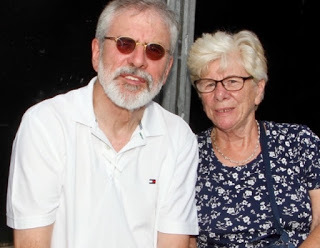 There is still a role in these more peaceful times for Green Cross, particularly helping the families of our patriot dead. Last week Pat McGivern, despite undergoing chemo treatment, was out collecting her Green Cross as usual. At the Cairde event we honoured Pat and Marguerite as warm, generous, unselfish, and very wonderful comrades who kept us safe and kept us grounded. I want to say thank you to them and to all the women and men who played their part in the PDF, Green Cross, An Cumann Cabhrach and the Republican Prisoners Welfare Committee. I started to name some of those involved over the decades in raising funds for the families of republican prisoners, including those in Northern America and Britain, but there are too many and as always someone would be left out.Suffice to say that without them some of us might not have survived.Thank you Marguerite. Go raibh maith agat Pat. And everyone else who helped.
There is still a role in these more peaceful times for Green Cross, particularly helping the families of our patriot dead. Last week Pat McGivern, despite undergoing chemo treatment, was out collecting her Green Cross as usual. At the Cairde event we honoured Pat and Marguerite as warm, generous, unselfish, and very wonderful comrades who kept us safe and kept us grounded. I want to say thank you to them and to all the women and men who played their part in the PDF, Green Cross, An Cumann Cabhrach and the Republican Prisoners Welfare Committee. I started to name some of those involved over the decades in raising funds for the families of republican prisoners, including those in Northern America and Britain, but there are too many and as always someone would be left out.Suffice to say that without them some of us might not have survived.Thank you Marguerite. Go raibh maith agat Pat. And everyone else who helped.
Published on May 31, 2019 01:16
May 23, 2019
THE NUMBERS GAME.
 Mise agus John Hume
Mise agus John HumeSeamus Mallon was never a big fan of the Hume-Adams talks. In 1985 Fr. Alex Reid – the Sagart - tried on at least three occasions to organise a meeting between me and Mr Mallon. He delayed and delayed. Despite further efforts by Fr. Reid after the Anglo-Irish Agreement was signed in November 1985, Mr. Mallon finally said no to a meeting in March 1986.
On May 19th 1986 Fr. Alec wrote to John Hume. John phoned Clonard Monastery the next day and the following day he met the Sagart. John and I met shortly afterwards. The Hume Adams initiative was a product of those talks. While there were other element and many more contributors the Peace Process grew out of them. So did the Good Friday Agreement.
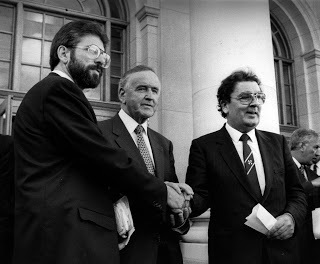 Mise agus Albert Reynolds and John at Government Buildings, Dublin
Mise agus Albert Reynolds and John at Government Buildings, DublinIn my opinion Seamus Mallon is not a big fan of the Good Friday Agreement. He wrongly blames it and the two governments on the decline of the SDLP and ignores other factors including his own role in this development. So his recent claim that a “united Ireland by numbers won’t work” comes as no surprise. It ignores the clear provisions of the Good Friday Agreement and undermines the equal and democratic value which should be given to every vote. Mr. Mallon’s proposition also seeks to rewrite the principle of consent contained within the Good Friday Agreement. His latest position gives an unintended insight into his role in the negotiations which led to the Good Friday Agreement. John Hume had a much more progressive and realistic position which did not accept an internal - that is a six county- settlement. That is one of the issues which we agreed on early in our talks in 1986. It was also an important element in talks between the SDLP and Sinn Féin in 1988 and in the first Hume Adams statement in April 1993. It is a central part of the Good Friday Agreement:. Mr. Mallon is now proposing that the constitutional and political landscape should be rewritten to provide unionism with an entrenched veto over the issue of rights, and in particular the right to self-determination and independence subverted by partition almost 100 years ago. He does acknowledge the failure of partition when the rights of nationalists and republicans were trampled on. How could he do otherwise? But he repeats that mistake by raising the democratic bar on unity in favour of unionism. He hasn’t moved beyond the deeply flawed Sunningdale Agreement. In short Mr. Mallon is saying that a unionist majority can maintain partition, and the Union with Britain, but a majority which favours a United Ireland cannot achieve this without the agreement of a majority of Unionists. As well as being at odds with the Good Friday Agreement, this stance is also in stark contrast to other majority decisions of significance taken in recent years. That is how EU treaties were decided in the South. Two recent referendums there on marriage equality and a woman’s reproductive rights were determined by a majority. The right of nationalists in the north to vote in an election for the Presidency of Ireland will be determined by a majority referendum vote later this year. If Scotland holds a referendum on the Union it too will be determined by a majority. If majorities are acceptable in those circumstances, why should a vote on Irish Unity be any different? Seamus Mallon’s proposal would also make the task of progressing a rights based agenda in the North even more difficult than it already is. Where is the sense of “belonging” in his “shared home place” if the first thing he argues for is the relegation of the rights of Irish language speakers and our LGBTQ+ citizens in the current negotiations? How can “safety, security and comfort” be achieved if not through the core principles of the Good Friday Agreement – equality and parity of esteem? And in case Mr. Mallon has forgotten, the collapse of the Assembly and Executive in 2017, and of the talks last year, was about more than language and marriage equality rights and the crass bigotry of some in the DUP. The British government and the DUP also refused to honour agreements, particularly around the issue of legacy. And then there was the scandal of the Renewable Heat Incentive (RHI). Hundreds of millions of pounds of public money squandered amid allegations of misconduct and corruption of DUP officials. As the political momentum and demand for unity is growing as a result of demographic and political changes, greater public politicisation, and the Brexit debacle, Mr. Mallon chooses this time to propose changing the Good Friday Agreement. He must know such a change will not be agreed. He wants nationalists and republicans to “stop pushing for unity”. We should set aside our legitimate desire for unity until “there is a wider and deeper acceptance of it among the unionist community.” How will we achieve that acceptance if we don’t encourage a conversation about the benefits of unity?Political change, and especially around such a vexed issue as partition, is only possible if the arguments for and against are debated publicly. We need a public discourse in which all of the claims and counterclaims; pros and cons can be discussed. Mr. Mallon’s proposition also misses the main achievement of the Good Friday Agreement. That Agreement is not a constitutional settlement. It never claimed to be one. By making consent a requirement for both the Union and Irish Unity it removes the constitutional veto once enjoyed by unionism. The Good Friday Agreement was and is an agreement based on equality and parity of esteem.
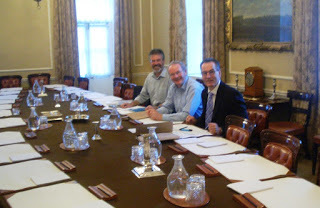 Negotiating in the Cabinet Room, Downing Street in 2004
Negotiating in the Cabinet Room, Downing Street in 2004Of course every sensible United Irelander wants the biggest majority possible for unity. That is the most desirable outcome of a referendum on unity. By dint of their numbers unionists have a very strong position. We cannot be blind to that. Persuading enough of them to take control of their own affairs in a new agreed Ireland is a historical challenge. Being aware, sensitive and committed to winning as many unionists as possible to an agreed future in a new Ireland, and being generous and imaginative about this is the only way forward. But it does not include inventing a new veto. Where in the tortured history of the northern state is there evidence to support the view that nationalists acquiescing to unionism ever worked? On the contrary – from the civil rights movement through the peace process, and the many periods of negotiations - progress has only been achieved when nationalists and republicans stood up for and asserted our rights alongside the rights of everyone else. Its equality Stupid! The thrust of Mr. Mallon’s argument is that a United Ireland born out of a unity referendum, with a narrow majority, risks a rerun of the past with the boot placed on the other foot. That nationalists and republicans would do to unionism what was done to us for generations. His argument is spurious and offensive. I know of no republican or nationalist who believes for one instance that we are so stupid, so narrow minded, so bigoted, so driven by hatred, as to do that. Nor do I believe that there is any popular support for a return to the conflict of the past. The last two decades have seen positive societal change. Citizens want that progress to continue. Seamus Mallon’s willingness to change the Good Friday Agreement and reintroduce the unionist veto threatens that progress and ignores the lessons and failures of partition. Finally, United Irelanders should continue to raise that objective wherever and whenever we can. In recent years there has been significant progress. Irish Unity is now firmly fixed on the political agenda. We will not take it off that agenda nor will we acquiesce to a new unionist veto. My preference is for a unitary state but as republicans have said many times we are open to agreeing transitional arrangements. In fact, transitional arrangements are a necessary part of our journey as an island people. As republicans we are working for a shared space - a new harmonious dispensation- in which sectarianism is a thing of the past and where people of every political persuasion and none can live, work and socialise together on the basis of equality. That’s the way forward.
Published on May 23, 2019 01:07
May 17, 2019
Counterinsurgency and Collusion – Britain’s dirty war in Ireland
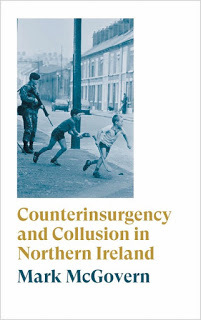 Over the decades many official and unofficial reports, pamphlets and books have been published examining the evidence for British state collusion with unionist paramilitaries in the murder of citizens. These include, reports by Amnesty International, the Barron report into the Dublin Monaghan bombings, reports by the North’s Police Ombudsman, the Pat Finucane Centre, by Canadian Judge Peter Cory; the de Silva report; and books like Ian Cobain’s ‘The History Thieves’; Unfinished Business: State Killings and the Quest for Truth by Bill Rolston: A Very British Jihad by Paul Larkin: and Lethal Allies by Anne Cadallader. Among many others.
Over the decades many official and unofficial reports, pamphlets and books have been published examining the evidence for British state collusion with unionist paramilitaries in the murder of citizens. These include, reports by Amnesty International, the Barron report into the Dublin Monaghan bombings, reports by the North’s Police Ombudsman, the Pat Finucane Centre, by Canadian Judge Peter Cory; the de Silva report; and books like Ian Cobain’s ‘The History Thieves’; Unfinished Business: State Killings and the Quest for Truth by Bill Rolston: A Very British Jihad by Paul Larkin: and Lethal Allies by Anne Cadallader. Among many others.Last week Mark McGovern’s ‘Counterinsurgency and Collusion in Northern Ireland.’ was published. It significantly adds to the body of evidence already available about Britain’s dirty war in Ireland and its use of unionist death squads and shoot-to-kill actions. McGovern’s book is hugely detailed and provides countless sources for the evidence it produces and the conclusions it draws. It acknowledges that there is not a “single cause of such institutional collusion” but rather a “confluence of forces.” The book examines the historical and political context for collusion, including partition and the creation of the Orange State; “The long-term sectarianised character of state and society in Northern Ireland undoubtedly played an important role.”
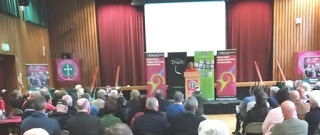 Geraldine Finucane speaking at Relatives for Justice Launch of book in St. Mary's
Geraldine Finucane speaking at Relatives for Justice Launch of book in St. Mary's
“Counterinsurgency and Collusion in Northern Ireland” details the various phases of organisation, structure and tactics that Britain’s counterinsurgency strategy and use of collusion went through from the early 70s until the late 1990s. It examines Britain’s “intelligence-led attritional strategy that generated a grey zone of official deniability around the criminal actions of state agents and informers designed to defeat an intractable enemy.”The book looks at the history of Britain’s imperial use of counter-insurgency as it sought to dominate its colonial possessions and the role of three former British Army officers who promoted the use of “irregular warfare”; Charles E. Callwell, Charles Gwynn and Frank Kitson. Callwell is especially interesting. He was an “Irish Unionist” who in 1896 wrote ‘Small Wars: Their principles and Practice’. The British Army’s current Counterinsurgency field manual acknowledges that this was the start of the formal use of counter-insurgency strategy by Britain. For Callwell counterinsurgency was the strategic use of violence against “lesser races” and “savage enemies” and those insurgents who “dog the footsteps of the pioneers of civilization.” As McGovern states: “Callwell was a stout advocate of a strategy of ‘butcher and bolt’; raids undertaken to destroy crops, livestock and buildings, to raze whole villages to the ground and lay waste to conquered areas that ‘fanatics and savages [could be] thoroughly brought to book and cowed … [so that they would not] rise up again.”McGovern also looks at how collusion, and the sharply dividing opinions of how it was used in the North, impacts today on the “often political divisive debates about how to deal with the legacy of the past and outstanding issues of truth and justice left in its wake.”
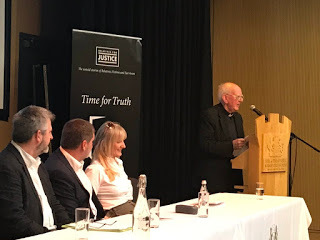 Fr. Raymond Murray speaking at launch in Dungannon of Counterinsurgency and Collusion
Fr. Raymond Murray speaking at launch in Dungannon of Counterinsurgency and Collusion While the primary geographical focus of this book is East Tyrone and South Derry – Mid Ulster – the book also looks at the role of the Military Reaction Force (MRF) in sectarian killings in Belfast; the emergence of the Force Reconnaissance Unit (FRU) which ran Brian Nelson and other agents, and was responsible for the murder of Pat Finucane; and the import of weapons from South Africa in 1987 – with the knowledge of British intelligence. It is worth remembering that the human cost of this weapons shipment can be found in the numbers killed in sectarian attacks. In the three years prior to receiving this weapons shipment unionist death squads had killed 34 people. In the three years after the shipment they killed 224 and wounded countless scores more.Ulster Resistance, which was founded by the DUP in 1986 played “the most critical part in the operation” to bring the weapons into the North. Looking at Mid Ulster McGovern states: “Between 1988 and August 1994 86 people were killed in East Tyrone … many with guns imported as part of the 1987 arms shipment.” Many of these were IRA Volunteers, Sinn Féin activists or their family members.All of this has to be seen in the context of the objective of the British state and the British Army, especially during the Thatcher years. In its report on Operation Banner, the name given to the 30 years of Britain’s War in Ireland, it states: “The British government’s main military objective in the 1980s was the destruction of PIRA, rather than resolving the conflict.”Collusion involving unionist paramilitaries was also interconnected to shoot-to-kill operations by British forces. McGovern states: “…collusion should not be seen in isolation but rather viewed in relation to broader state counterinsurgency – particularly evidence of a shoot-to-kill policy, conducted primarily by specialist units of the RUC and British Army, directed against republicans”.In East Tyrone between 1983 and 1992 26 IRA volunteers were assassinated, including at eight at Loughgall, along with one civilian. McGovern reviews many of these events in detail. He also examines the circumstances surrounding the killings of Gerard Casey; Liam Ryan and Michael Ryan in the Battery Bar, Ardboe; Malcolm Nugent, Dwayne O’Donell, John Quinn and Tomas Armstrong in Cappagh; Sinn Féin Councillors John Davey and Bernard O’Hagan; Kathleen O’Hagan, Tommy Casey and Patrick Shanaghan and sadly many more. McGovern’s book begins and ends its examination of individual cases with the murder of Roseann Mallon exactly 25 years ago on 8 May 1994.
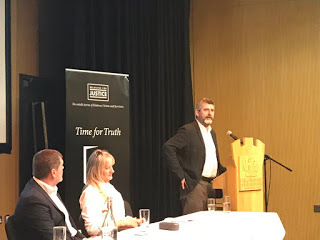 Professor Mark McGovern at Dungannon launch
Professor Mark McGovern at Dungannon launch
At the time of the attack on her home it was under constant surveillance by British Army covert units, who were in “constant, direct contact with an officer at their base who was overseeing matters”. There were also cameras relaying images to a nearby base “home to British Army specialist units such as the Special Air Service (SAS).” At the inquest it was revealed that evidence “had not been provided, disappeared, been lost, tampered with or destroyed by the policy – including suspect interview notes, police officers’ notebooks, and last but by no means least, the wiped video footage taken from the covert British post on the day of the killing… Getting to the truth was also hindered by the refusal of some former policemen, servants of the law to co-operate with the court and the lengthy, drawn out battles to overcome official barriers put in the way of disclosure.”In his conclusion McGovern addresses the claim of a witch-hunt by former British military personnel and the unionist and Tory parties and media. He concludes that “the record rather suggests a long-term de facto immunity and a priori amnesty for military wrongdoing”. He notes that “only four British soldiers were convicted for murder in the North of Ireland … in each case the soldier in question served less than three years in jail before being released and returned to the ranks of the British Army.” “Counterinsurgency and Collusion in Northern Ireland” adds significantly to our knowledge of how this British military and political policy worked. It provides much new sourced detail. It also gives an important insight into why successive British governments have constantly blocked progress on legacy issues.
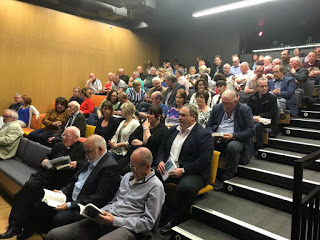 Dungannon launch
Dungannon launch
Published on May 17, 2019 02:56
May 9, 2019
Ballymurphy never went to war - the war came to Ballymurphy.
I have watched with awe and huge admiration the courage and steadfastness of the families of those killed in Ballymurphy in August 1971 throughout their long campaign to get to the truth of what happened on our streets 48 years ago. The current inquest has been a difficult experience for them. They have had to listen to the lies and spin from former British soldiers seeking to justify their killing of Fr. Hugh Mullan, Francis Quinn, Daniel Teggart, Joan Connolly – a mother of eight - Joseph Murphy, Noel Phillips, Edward Doherty, John Laverty, Joseph Corr and John McKerr. An 11th man, local community worker Paddy McCarthy, died from a heart attack after a British army patrol subjected him to a mock execution. Eleven families lost loved ones and 57 children were bereaved.
The year before internment Sinn Féin organised a petition in Ballymurphy for British soldiers to leave the area. About 97% of the community voted ‘Yes’. Ballymurphy was not what one would call a Republican community at that time. Through 1970 and in the months leading up to August 1971 the British Army pumped countless gallons of CS Gas into the area . They used rubber bullets and generally intimidated everyone, including women and children. A range of community organisations came together to resist them. These included the Hen Patrols, Citizens Defence and so forth. There were acts of resistance every day. It was communal activity. Ballymurphy never went to war. Rather the war came to Ballymurphy.
Some time ago I was asked by the Coroners Service to make a statement about my knowledge of those events. I gave them a statement in January and subsequently agreed a longer, more formal statement. Three weeks ago I received a letter from the Coroners Service formally asking me to attend the Ballymurphy Inquest on Wednesday to give evidence as a witness. Below is the statement which I prepared.
My Statement to the Coroner’s Service:“My name is Gerry Adams. I was formerly the MP and MLA for west Belfast. And since 2011 I have been a Teachta Dála (TD) for the constituency of Louth.During the interment swoops of August 9th 1971 my family home was 11 Divismore Park, Ballymurphy. My family had lived there since the house was built in the1950s. Divismore Park is directly opposite the Henry Taggart Church Hall on the Springfield Road. At the time of internment, and for some time before this, the Taggart was occupied by the British Army. They were also on the roof of the Vere Foster School behind the Henry Taggart.I am a republican. My family, maternally and paternally, have been involved in republicanism since before partition. I became active in republican politics in my mid-teens in the mid-1960s. I joined Sinn Féin, which was then an illegal organisation under the Special Powers Act.I was active locally in west Belfast in campaigns for decent housing and in civil rights agitation and in Ballymurphy in community politics. I was a founder member of the west Belfast Housing Action Committee and a founding member of the Northern Ireland Civil Rights Association. Later I was elected to the local Belfast committee.After the Belfast pogroms in August 1969 I left paid employment to become a full-time Sinn Féin activist. Along with many others I was involved in providing assistance to thousands of refugees who flooded into west Belfast. I also worked with the Central Citizens Defence Committee which co-ordinated the community response to the refugee crisis.At that time parts of Belfast were barricaded by local residents. The RUC and British soldiers were excluded by local nationalist and republican communities.I worked with a range of community organisations which sprang up around that time. They basically organised their neighbourhoods. This was the time of very widespread civil disobedience and the withdrawal of nationalists from the structures of the state.In Ballymurphy and the Upper Springfield there was a quite a sophisticated and very democratic community structure involving the Ballymurphy Tenants Association, other community organisations, Sinn Féin. Street Committees and Youth Committees, a Citizen’s Defence Committee, Ex British Servicemen’s Association, and Women’s Groups, including Hen Patrols. There were also two IRA groups, popularly known as the Officials and the Provisionals.The British Army’s attitude to the local community was very brutal, and from 1970, within a short time of them arriving on the streets, there was regular and sustained street fighting. This was mainly local people resisting a very aggressive occupation.Ballymurphy in particular was often saturated with British patrols; riot squads were deployed daily; and CS gas and rubber bullets were used in huge numbers. At the time of internment, I was the Chairperson of the local Sinn Féin Cumann or branch in the Upper Springfield, including Ballymurphy.The politics of the area had changed immensely since August 1969. By the time of internment in 1971 the people of Ballymurphy were a risen people, a community united in opposition to the injustices imposed upon them. Most of the street fighting which had taken place in 1970 and early 1971 did not involve the use of firearms. It was normally bricks, bottles, stones, petrol bombs and occasionally blast bombs.11 people died in the Upper Springfield as a result of the conflict in the three days following internment. I did not witness any of these killings. I believe all those who died were killed by the British Army. My account of these events in one of my books, Before the Dawn, is drawn from conversations with people at the time or shortly afterwards, or as a result of research I undertook, including contemporary media reports, when writing Before the Dawn in 1995.Internment was introduced shortly before 4 am on the morning of Monday August 9th 1971. I was not at home. I was in a friend’s house in Springhill which is an adjoining housing estate. My family home was raided. My father and my brother Liam, who was 14, were arrested.The Parachute Regiment evicted my mother and the rest of the family and occupied the house. They wrecked it so much that my mother was never able to return. The house was subsequently demolished.The British Army withdrew to the outskirts of the area after the initial raid and arrest operation. A number of local community leaders were among those arrested and badly beaten and local people congregated at the Henry Taggart in protest.The British Army deployed riot squads, a water cannon and fired rubber bullets and CS gas. Around mid-afternoon on the 9th August homes in Springfield Park were attacked by loyalists from Springmartin. There was shooting by the British Army and possibly also by loyalists from Springmartin.That fire was returned by a small number of IRA volunteers from Moyard. They then withdrew. The rioting continued sporadically all the rest of that afternoon and evening as some families were evicted from Springfield Park by Loyalists.That night around 9pm a number of people were killed and injured on waste ground between Moyard and Springfield Park by the British Army firing from Springmartin. At the same time other British soldiers had opened fire from the Henry Taggart into Ballymurphy.A number of people were killed opposite the Henry Taggart in a field between Ballymurphy and Springhill. There was no IRA firing at that time. I was in Springhill. The firing from the Henry Taggart was very intense although we were sheltered from this.I witnessed a young boy, Eddie Butler, who had been wounded being rescued by local people. During a lull in the British Army firing from the Taggart he and some other boys were encouraged to crawl from the undergrowth where they were trapped, through wire and a hedge into Springhill.The wounded boy was put on a door, which someone produced, and he was taken in a house where first aid was administered by the Knights of Malta before he was taken away by ambulance.During this rescue I saw two masked IRA Volunteers go toward the top of Springhill Avenue. I then heard firing from that area. I was later told that they had fired toward British troops who were across the Springfield Road on the high ground at Springmartin or in or around Glenravel School. It was not possible to fire at the Henry Taggart from the top of Springhill Avenue”.
Published on May 09, 2019 03:05
May 2, 2019
We Shall Overcome
In February 2018, Sinn Féin and the DUP negotiating teams and leaders closed on a draft agreement to be considered by our leaderships. The DUP leader Arlene Foster failed to get the support of her Officer Board. The talks collapsed in recriminations. At that time I wrote: “It is not the end. The shutter has been pulled down on this phase of talks but ultimately all of the parties, Sinn Féin, Alliance, SDLP and the UUP and DUP, along with the two governments, will at some point in the time ahead be back around the same table, negotiating.” And that’s where the parties and two governments will be when a new round of talks commence next week.
The murder of Lyra McKee, and public revulsion at the actions of those responsible, has been the main catalyst for this at this time. The British Government seized the moment and announced a ‘new’ talks process. The Irish Government has bought into this. The shock, outrage and sadness at Lyra’s death has highlighted the widespread desire for progress. People want solutions to the political impasse at Stormont. They want local politicians taking responsibility for those issues that are impacting on citizens, in health and education and the environment and much more. They want to hold these politicians accountable for their decisions. But those who support Sinn Féin and wider opinion do not want a return to the status quo. They want the power sharing government to be rights based. That means as a first step there needs to be commitments that rights currently being denied will be delivered.
As two decades of negotiations through the peace process have shown, finding solutions to long standing issues of dispute is not easy. It is often hugely time consuming. But it has been done. Positive change – significant progress - can be achieved when the political will is created.
The Good Friday Agreement is perhaps the best example of this. But as George Mitchell pointed out at the time – that was the easy bit – implementing the agreement would be much more challenging. He was right. Remember, the DUP absented itself from those talks. Some UUP representatives, now prominent in the DUP, walked out. It took almost a decade for Sinn Féin to agree a power sharing government with the DUP.
Sinn Féin has consistently worked in good faith within the power sharing government. Our objective was and is to deliver for citizens. A lot of good work was done by the Executive and the Assembly and significant progress was made on many issues, including on cross border and all-Ireland matters. However, the DUP consistently tried to hollow out the Agreement. They removed Ian Paisley as leader because he was perceived by some to be too friendly with Martin McGuinness. The Church which he founded got rid of him.
Martin and Peter Robinson, who took over from Ian Paisley, had a decent working relationship. But it was a battle a day. For Peter I am sure, as well as Martin. There were also very serious allegations - unproven so far - of wrong doing by some senior DUP figures around NAMA and other important issues. All the while the DUP approach was minimalist on equality issues. As a consequence, there was little or no progress on important matters. For example, 21 years after the Good Friday Agreement, there is still no Bill of Rights.
When Peter Robinson retired, Arlene Foster’s use of offensive terms to describe Irish speakers and others highlighted the DUP’s antipathy toward the equality and mutual respect elements of the Good Friday Agreement and its disrespect for Irish identity and culture. This was most clearly evident in its antagonism toward the Irish Language. In a changing Ireland DUP opposition to marriage equality, its resistance to positive efforts to support women’s’ health initiatives; its refusal to honour commitments it gave on legacy matters made matters worse. And then came the costly debacle of the Renewable Heat Initiative (RHI) scandal! A perfect storm which increased the toxic atmosphere within the Executive and the Assembly.
Much of this DUP negativity is fed by the fear political unionism has for the democratic and demographic changes that have been taking place over the last two decades. According to the most recent census results those who identify as British now make up less than half of the population of the North. In the 2017 Assembly election, for the first time since partition, the UUP and DUP won less than half of the Assembly seats. But change is also obvious in the nationalist middle class. Civic republicanism has emerged as a real and growing grassroots movement for rights and equality. Brexit - and the British Government and the DUPs disregard for the referendum vote - has been an accelerant for this movement.
So, let’s be clear about some basics. The British government is not about to implement previous Agreements it has failed to honour thus far. It is more concerned with process at this time than product. The British Government has bigger fish to fry. The Union to one side, Mrs May really doesn’t care about the North. In the midst of the Brexit madness at Westminster she will not stand up to her DUP partners in government and insist that those fundamental human rights available everywhere else on these islands should also be available for citizens in the North. She is badly served by Karen Bradley. The current British Secretary of State has proven herself more incapable than any of her many mediocre predecessors. And anyway now courtesy of Brexit many people in Ireland and abroad have seen close up the arrogance, ignorance and downright stupidity and incompetence of British parliamentarians. What right thinking person would want to be governed by idiots like them? At least if we had self-government we could sack our own idiots when we want to.
The murder of Lyra McKee has not changed any of this. That is the sad reality. Of all the parties Sinn Féin, rooted in republican communities, and at considerable risk to ourselves and our families, has stood firmly against these anti peace armed gangs like the one which killed Lyra. The political parties cannot be blamed for her death, although those who have a dead hand on the process of change should reflect on the need to make politics work. For everyone.
Labelling Lyra’s killers as dissidents is lazy commentary. To dissent is an honourable position. These groups, heavily infiltrated by the policing agencies, serve no purpose whatsoever in the political struggle. Her death came during a US Congressional Delegation visit to Ireland and Britain. Speaker Pelosi and Congress leader Richie Neal were forthright and clear in their admonishments of the Brexiteers and on their commitment to the Good Friday Agreement.
Lyra McKee was a victim of stupidity and nihilism. It struck me as particularly poignant that she was gunned down on the twenty first anniversary of the Good Friday Agreement. It is also particularly sad that this thoroughly modern young woman and her fiancée were denied the right to marriage equality by the DUP. Surely a fitting tribute to her and her bright young life would be to have this right legalised as soon as possible. No ifs or buts. Just like everywhere else on these islands.
Until the DUP accept or acquiesce to this and other rights the power sharing government cannot function properly. DUP leaders know this. They also know that there will be marriage equality, an Irish Language Act and other rights. It is a matter of when, not if. An Tánaiste, Simon Coveney, knows this also. So does the Taoiseach.
As always Sinn Féin will do our best. I am sure our leaders will encourage the DUP to have these matters resolved as soon as possible. The Irish Government needs to do likewise. The Taoiseach is a co-equal guarantor of the Good Friday and other agreements. Let us be positive. We will have our rights. We shall overcome.
Published on May 02, 2019 06:41
April 28, 2019
Songs, poems,words of Easter Week
Many fine words, songs and poems have been written about the Easter Rising of 1916. Some were written by those who waited in the prisons to be executed. Others were personal recollections of that period written by those outside of the prisons, in the weeks, months and years after the Rising. They were moved by the courage and tenacity of the 1916 Leaders and by the individual stories of bravery of those who participated in that great event.In 1966 the Merry Ploughboy by Dermot O’Brien was number 1 for six weeks in the Irish charts. It was hugely popular and remains so today:And we're all off to Dublin in the green, in the green
Where the helmets glisten in the sun
Where the bay'nets flash and the riffles crashTo the rattle of a Thompson gun.
Kevin Barry has been a perennial favourite which has been recorded many times over the years, including by Paul Robson and Leonard Cohen. The Clancy Brothers and Tommy Makem sang Freedom’s Sons: They were the men with a vision, the men with a cause
The men who defied their oppressor's laws
The men who traded their chains for guns
Born into slav'ry, they were Freedom's Sons Rod Stewart has recorded Grace which tells of the love and marriage of 1916 Joseph Plunkett and Grace Gifford just hours before his execution:Oh Grace just hold me in your arms and let this moment linger
They'll take me out at dawn and I will die
With all my love I place this wedding ring upon your finger
There won't be time to share our love for we must say goodbye
And there are countless more songs and poems. Most of these songs were about men but many of today’s singers correct that. There are very few songs in Irish about the Rising but Sean O’Riada’s icon, classic music score for the film Mise Éire will still stir the heart and the spirit. These are some of my personal words and poems and lyrics. Enjoy:Address to Court Martial: Pádraic Mac Piarais: “Believe that we, too, love freedom and desire it. To us it is more desirable than anything in the world. If you strike us down now, we shall rise again and renew the fight. You cannot conquer Ireland. You cannot extinguish the Irish passion for freedom. If our deed has not been sufficient to win freedom then our children will win it by a better deed.” Connolly by Liam MacGabhannThe man was all shot through that came today
Into the barrack square;
A soldier I - I am not proud to say
We killed him there;
They brought him from the prison hospital;
To see him in that chair
I thought his smile would far more quickly call
A man to prayer.
Maybe we cannot understand this thing
That makes these rebels die;
And yet all things love freedom - and the Spring
Clear in the sky;
I think I would not do this deed again
For all that I hold by;
Gaze down my rifle at his breast - but then
A soldier I.
They say that he was kindly - different too,
Apart from all the rest;
A lover of the poor; and all shot through,
His wounds ill drest,
He came before us, faced us like a man,
He knew a deeper pain
Than blows or bullets - ere the world began;
Died he in vain?
Ready - present; And he just smiling - God!
I felt my rifle shake
His wounds were opened out and round that chair
Was one red lake;
I swear his lips said 'Fire!' when all was still
Before my rifle spat
That cursed lead - and I was picked to kill
A man like that! For What Died The Sons Of Róisín: Luke KellyFor what died the sons of Róisín, was it fame?
For what died the sons of Róisín, was it fame?
For what flowed Irelands blood in rivers
That began when Brian chased the Dane
And did not cease nor has not ceased
With the brave sons of '16
For what died the sons of Róisín, was it fame?For what died the sons of Róisín, was it greed?
For what died the sons of Róisín, was it greed?
Was it greed that drove Wolfe Tone
To a paupers death in a cell of cold wet stone?
Will German, French or Dutch inscribe the epitaph of Emmet?
When we have sold enough of Ireland to be but strangers in it
For what died the sons of Róisín, was it greed?To whom do we owe our allegiance today?
To whom do we owe our allegiance today?
To those brave men who fought and died
That Róisín live again with pride?
Her sons at home to work and sing
Her youth to dance and make her valleys ring
Or the faceless men who for Mark and Dollar
Betray her to the highest bidder
To whom do we owe our allegiance today?For what suffer our patriots today?
For what suffer our patriots today?
They have a language problem, so they say
How to write "No Trespass" must grieve their heart full sore
We got rid of one strange language
Now we are faced with many, many more,
For what suffer our patriots today?
The Foggy Dew: Charles O’NeillAs down the glen one Easter morn to a
city fair rode I
There armed lines of marching men in
squadrons passed me by
No fife did hum nor battle drum did
sound its dread tattoo
But the Angelus bell o’er the Liffey swell
rang out through the foggy dew Right proudly high over Dublin town
they hung out the f lag of war
’Twas better to die ’neath an Irish sky
than at Suvla or Sedd El Bahr
And from the plains of Royal Meath
strong men came hurrying through
While Britannia’s Huns, with their
long-range guns sailed in through the
foggy dew ’Twas Britannia bade our Wild Geese go
that small nations might be free
But their lonely graves are by Suvla’s
waves or the shore of the Great North Sea
Oh, had they died by Pearse’s side or
fought with Cathal Brugha
Their names we will keep where the
Fenians sleep ’neath the shroud of the
foggy dew But the bravest fell, and the requiem bell
rang mournfully and clear
For those who died that Eastertide in
the springing of the year
And the world did gaze, in deep amaze,
at those fearless men, but few
Who bore the fight that freedom’s light
might shine through the foggy dew Ah, back through the glen I rode again
and my heart with grief was sore
For I parted then with valiant men
whom I never shall see more
But to and fro in my dreams I go and
I’d kneel and pray for you,
For slavery f led, O glorious dead,
When you fell in the foggy dew
Statement by James Connolly to his Court Martial: May 9th, 1916:“We went out to break the connection between this country and the British Empire, and to establish an Irish Republic. We believed that the call we then issued to the people of Ireland, was a nobler call, in a holier cause, than any call issued to them during this war, having any connection with the war. We succeeded in proving that Irishmen are ready to die endeavouring to win for Ireland those national rights which the British Government has been asking them to die to win for Belgium. As long as that remains the case, the cause of Irish freedom is safe.Believing that the British Government has no right in Ireland, never had any right in Ireland, and never can have any right in Ireland, the presence, in any one generation of Irishmen, of even a respectable minority, ready to die to affirm that truth, makes that Government for ever a usurpation and a crime against human progress”.
Published on April 28, 2019 01:47
April 19, 2019
Wouldn’t it be better?
Wouldn’t it be better if the British government, the Irish government and the DUP upheld the Brexit referendum vote in the North to remain in the EU?Yes NoWouldn’t it be better if there was no hard border?Yes NoWouldn’t it be better if there was no border at all?Yes NoWouldn’t it be better if the rights of every citizen on the island of Ireland were upheld in law?Yes NoWouldn’t it be better if the British government honoured its commitments under the Good Friday and subsequent Agreements? Yes NoWouldn’t it be better if the Irish government honoured its commitments under the Good Friday and subsequent Agreements?Yes NoWouldn’t it be better if the British government refused to accept a Unionist veto over the rights of citizens available elsewhere on these islands, except the North?Yes NoWouldn’t it be better if the Irish government pro-actively and publicly campaigned for these rights and for the right of Irish citizens living in the North and overseas to vote in Presidential elections? Yes NoWouldn’t it be better if the Irish government honoured the commitment in the Good Friday Agreement negotiations to allow MPs elected in the North to attend and speak in the Dáil -without voting rights?Yes NoWouldn’t it be better if the British government accepted the right of citizens in the North to identify as Irish or British or both and to honour that right in legislation?Yes NoWouldn’t it be better if the Irish government privately and publicly challenged the British government on its refusal to accept the right of citizens in the North, enshrined in the Good Friday Agreement, to identity as Irish?Yes NoWouldn’t it be better if our future was based on tolerance and rights?Yes NoWouldn’t it be better if there was no place for sectarian politics, segregation, gender or racial discrimination?Yes NoWouldn’t it be better if the island of Ireland was a leader in tackling climate change?Yes NoWouldn’t it be better if every citizen had the right to a home, to a job, to education at all levels and access to health care at the point of delivery?Yes NoWouldn’t it be better if we lived in a society in which neither gender or race, age or disability, sexual orientation or class, or creed or skin colour or location was used to deny citizens their full rights and entitlements?Yes NoWouldn’t it be better to live in a society – a place of opportunity and equality in which there is no denial of rights and where every single person, despite our differences, is equal?Yes NoWouldn’t it be better if there was full co-operation across our island on public services, as well as agriculture, tourism, fishing, the environment, health, education, policing and other services?Yes NoWouldn’t it be better if health services in the North were available to people from the South and vice versa?Yes NoWouldn’t it be better if we lived in a society that upheld and defended workers’ rights, ended the crisis in housing and homelessness across this island?Yes NoWouldn’t it be better if we had an all-island economy that created more employment, better paid jobs, ended the scourge of zero hour contracts, and treated workers with respect? Yes NoWouldn’t it be better if we had one policing and justice system for the island of Ireland?Yes NoWouldn’t it be better if these matters were agreed between the people who live on the island of Ireland without interference from others?Yes NoWouldn’t it be better to live in a new, shared Ireland in which people of all religions and none, whether unionist or nationalist or republican or none, have the same entitlement to the full ownership of that new Ireland??Yes NoWouldn’t it be better if we started planning for this?Yes NoWouldn’t it be better if the people of the North and the South on the opportunity to agree on our future?Yes NoWouldn’t it be better if, instead of engaging in negative carping and criticising as divisive efforts to achieve a united, modern and shared Ireland, Fine Gael, Fianna Fáil and others in the South agreed to establish a Forum which could plan for and win a United Ireland?Yes NoWouldn’t it be better if the Irish government supported the demand for a referendum on Irish Unity as set out in the Good Friday Agreement?Yes No
Published on April 19, 2019 08:29
April 14, 2019
Institutional Racism
Four years ago a horrific fire at a so-called ‘temporary halting site’ at Carrickmines in Dublin claimed the lives of ten people – five adults and five children. Thomas and Sylvia O’Connor and their three children Jimmy aged 5, Christy aged 2 and Mary aged five months; Willy Lynch, his partner Tara Gilbert, their daughters Jodie aged 9 and Kelsey aged 4, and Willy’s brother Jimmy, were all killed. Tara was also pregnant at the time. It was the state’s biggest fatal fire since the Stardust night club disaster in 1981 which killed 48 people.There was an outpouring of grief and solidarity in the weeks after the Carrickmines tragedy. Books of condolences were opened, public vigils were held, and flags were flown at half-mast. I attended the funerals in Bray and Sandyford. At Sandyford I arrived as the haunting lament from a lone Uilleann piper echoed around the Church. The funerals were desperately sad.At the inquest in January it emerged that a chip-pan was the source of the fire. But the inquest also heard that the site was originally established in 2008 as an ‘emergency temporary site’. Under Department of Environment Guidelines for Traveller Accommodation (1998) such ‘temporary sites’ should not exist for more than five years. It also calls for at least six metres between mobile homes. At Carrickmines the structures were within one metre of each other. In the aftermath of the fire the government established an interagency group to agree a needs assessment for the survivors. I met with Tánaiste Simon Coveney who promised to take the steps necessary to ensure that the surviving family members would be properly supported by the state.Last July Mary Lou McDonald and I visited the Connors family. We met Jim and Josie Connors who are the grandparents of the two surviving young sons of Thomas and Sylvia Connors. Michael was six when his parents perished. He was staying with his grandparents the night the fire struck. Thomas, who is two years younger, was pulled from the mobile by 14 year old John Keith Connors only seconds before a ‘flashover scenario’ occurred which saw the burning chip pan explode in an inferno that engulfed the mobile. The inquest jury recommended that John should be nominated for a bravery award for his courage in rescuing his four year old nephew. Josie and Jim – who has significant health issues – told us of the pressures they face rearing two active young boys. Their primary concern was the need for school transport to take Michael and Thomas to school each day. For Josie, who is also caring for her husband Jim, that means four trips each day. It is an exhausting experience. Since our meeting I have tried to get a succession of Ministers to remove this burden from the family.I wrote to Tánaiste Simon Coveney on July 12th2018. The issue was referred by his office to the Minister for Housing, Eoghan Murphy.I also wrote to the Minister for Education Richard Bruton TD and the Minister for Social Protection Regina Doherty TD on the basis that the provision of school transport for the children had the potential to be deferred to a number of different government departments. Minister Eoghan Murphy TD responded with an acknowledgement in September 2018. He advised the issue was one for the local Council. A few months later he wrote to say it had been referred. Minister Regina Doherty TD’s office phoned last September to advise that the matter was a matter for the Minister for Education. I also made written representations to the Minister for Transport Shane Ross TD, having spoken with him personally in the Dáil last November. In a letter I received from him in February I was told that the provision of school transport for two young children had been referred to the Minister of State at the Department of Education John Halligan TD.I had already raised the needs of the two youngsters with Minister Halligan last November. I made further representations to him in January with no outcome. Despite significant contact by phone, no solution was offered, except to apply for School Transport scheme - which the family don’t qualify for. In January 2019 I again made written representations to Minister Shane Ross TD - with no response. I have spoken in person with Minister Shane Ross TD and the Tánaiste Simon Coveney TD. There has been no progress.Last Thursday I raised the matter in the Dáil with the Tánaiste Simon Coveney TD, during questions on Promised Legislation. I asked the Tánaiste when the commitment he made to me about fully supporting the Connors family would be honoured? He said he would get back to me. The prevarication, stalling, obfuscation, delays, evasion that have marked the government’s refusal to take the steps promised and provide the supports for Michael and Thomas, are a source of deep disappointment.Their experience is indicative of the many challenges facing the Traveller community in terms of housing, health, and especially mental health services, employment opportunities, and indifference and hostility from state institutions and local government structures.The European Committee on Social Rights has found that the Irish state is in violation of the European Social Charter on five grounds by failing to provide adequate Traveller Accommodation. A report of the Traveller Accommodation Expert Group which was established to look at this issue will be published within the next few weeks. It is vital that this report effectively confront the institutional racism which is at the heart of much of the objections to accommodation for Travellers.The needs of young boys – survivors of a horrendous tragedy that claimed their parents and siblings – are being ignored by Ministers who are passing this issue from one to another while doing absolutely nothing. Two years ago the Irish government announced its decision to recognise Traveller ethnicity. It was the right thing to do. I said then that legislative protections needed to follow. But if the institutions of the state cannot find within themselves the means to help two children – two survivors of a dreadful human tragedy – then what hope is there for those same institutions confronting the institutional racism that condemns the Traveller community as the most socially disadvantaged group in Irish society.
Published on April 14, 2019 05:57
Gerry Adams's Blog
- Gerry Adams's profile
- 29 followers
Gerry Adams isn't a Goodreads Author
(yet),
but they
do have a blog,
so here are some recent posts imported from
their feed.



